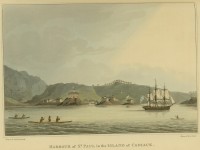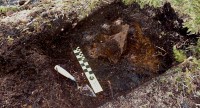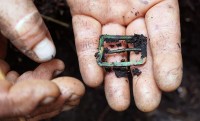Archaeologists in Sitka, southeast Alaska, have found the camp made by survivors of the wreck of the Russian ship Neva in January of 1813 while they awaited rescue.
 The Neva was a famous ship in its day. The three-masted 200-foot vessel began life in 1801 as the British merchant ship Thames but was acquired by Russia in 1802 and renamed Neva after the river that flows through Saint Petersburg. The Neva and another formerly English ship (the Leander, renamed Nadezhda) that had been purchased at the same time set sail together in 1803 from Kronstadt on a three-year voyage that would be the first Russian circumnavigation of the Earth.
The Neva was a famous ship in its day. The three-masted 200-foot vessel began life in 1801 as the British merchant ship Thames but was acquired by Russia in 1802 and renamed Neva after the river that flows through Saint Petersburg. The Neva and another formerly English ship (the Leander, renamed Nadezhda) that had been purchased at the same time set sail together in 1803 from Kronstadt on a three-year voyage that would be the first Russian circumnavigation of the Earth.
In October of 1804, the Neva, now separated from the Nadezhda, was in Sitka where the Russian-American Company deployed it against the Tlingit nation. The Tlingit had been fighting to get the Russians out of their territory for years, culminating in the destruction of the Russian outpost of Redoubt Saint Michael in 1802. It took a couple of years, but Russia got its revenge when the Neva and three other smaller ships bombarded the Tlingit fort for three days, ultimately forcing the tribespeople to retreat north to Chichagof Island.
 After their victory in the Battle of Sitka, the Russians founded the permanent settlement of New Archangel which in 1808 became the capital of Russian America. A flourishing commercial center when Seattle, Portland and San Francisco were but a twinkle in Manifest Destiny’s eye, New Archangel is where Russian minister Eduard de Stoeckl and Secretary of State William Seward signed the agreement selling Russian America to the United States for $7.2 million in April of 1867. The official transfer of the territory from Russia to the United States took place at New Archangel on October 18th, 1867. The city’s name was changed to Sitka when Russian America became the U.S. Department of Alaska after the transfer.
After their victory in the Battle of Sitka, the Russians founded the permanent settlement of New Archangel which in 1808 became the capital of Russian America. A flourishing commercial center when Seattle, Portland and San Francisco were but a twinkle in Manifest Destiny’s eye, New Archangel is where Russian minister Eduard de Stoeckl and Secretary of State William Seward signed the agreement selling Russian America to the United States for $7.2 million in April of 1867. The official transfer of the territory from Russia to the United States took place at New Archangel on October 18th, 1867. The city’s name was changed to Sitka when Russian America became the U.S. Department of Alaska after the transfer.
A month after the battle, the Neva continued on its long, slow trip around the world, carrying fur seal pelts from Alaska to China and in 1807 becoming the first Russian ship to visit mainland Australia. In 1812, the Neva headed back to Sitka but was damaged in treacherous weather on the three-month journey from Siberia. With a stop in Prince William Sound, the ship almost made it only to wreck less than 10 miles from Sitka off Kruzof Island on January 9th, 1813. Of the 75 souls on board when the Neva departed Okhotsk, Siberia, in August, 32 died in the wreck. Another 15 had died on the way leaving 28 men to make it to dry land. The survivors had to make do on their own in the depths of an Alaskan winter for 24 days until they were rescued. Two men didn’t make it.
The rescued crew members were taken to safety in Sitka, but despite the importance of the wrecked ship, their experience was barely documented at the time. There are no known official records extant today relating to the wreck, the rescue of the survivors and their month of hardship. The location of the camp was lost.
 In 2012, the U.S. Forest Service, the Alaska Office of History and Archaeology and the Sitka Historical Society sponsored a survey of a site they had reason to believe might be the survivors’ camp. They dug a few test pits and found two caches of Russian axes. Using archival research, Tlingit oral histories, and analysis of the landscape, the team also found an area near the shore they think may be the site of shipwreck.
In 2012, the U.S. Forest Service, the Alaska Office of History and Archaeology and the Sitka Historical Society sponsored a survey of a site they had reason to believe might be the survivors’ camp. They dug a few test pits and found two caches of Russian axes. Using archival research, Tlingit oral histories, and analysis of the landscape, the team also found an area near the shore they think may be the site of shipwreck.
This year an international team of Russian and American researchers funded by the National Science Foundation returned to the site for a more extensive archaeological excavation.
In July, researchers discovered at the campsite a series of hearths with early 19th century artifacts such as gun flints, musket balls, pieces of modified sheet copper, iron and copper spikes, a Russian axe, and a fishhook fashioned from copper. Well-preserved food middens–or refuse heaps–will allow reconstruction of the foraging strategies the sailors used to survive.
Gun flints found at the site appeared to have been used by survivors to used start fires, by striking them against steel. Historical accounts credit a firearm used in this manner with helping save the crew from hypothermia. Physical evidence indicates the survivors tried to whittle down musket balls to fit a smaller caliber weapon, such as a flintlock–most likely the same firearm mentioned in the historical accounts. Some of the copper spikes recovered by archaeologists had been broken through shear stress, such as a wreck would produce. The researchers believe one copper or brass artifact is part of a set of a navigator’s dividers, saved by a crewman as the ship violently broke apart over rocks.
The nature of the artifacts seems to strongly indicate that survivors of the shipwreck were active in ensuring their own survival. They modified wreckage in desperation, but with ingenuity.
 No artifacts indicative of settlement — ceramic, glass — were found, just the kind of cleverly improvised objects that shipwreck survivors would fashion to make it until the rescuers arrived.
No artifacts indicative of settlement — ceramic, glass — were found, just the kind of cleverly improvised objects that shipwreck survivors would fashion to make it until the rescuers arrived.
Even though Russians had a hugely significant presence in Alaska for more than a century before 1867, very few Russian sites have been excavated. The Neva survivors’ camp and the shipwreck therefore have the potential to answer a great many questions about the history of Russian America, particularly because they are so narrowly focused in time. They are a snapshot of the Russian presence in Alaska as it was in January of 1813.